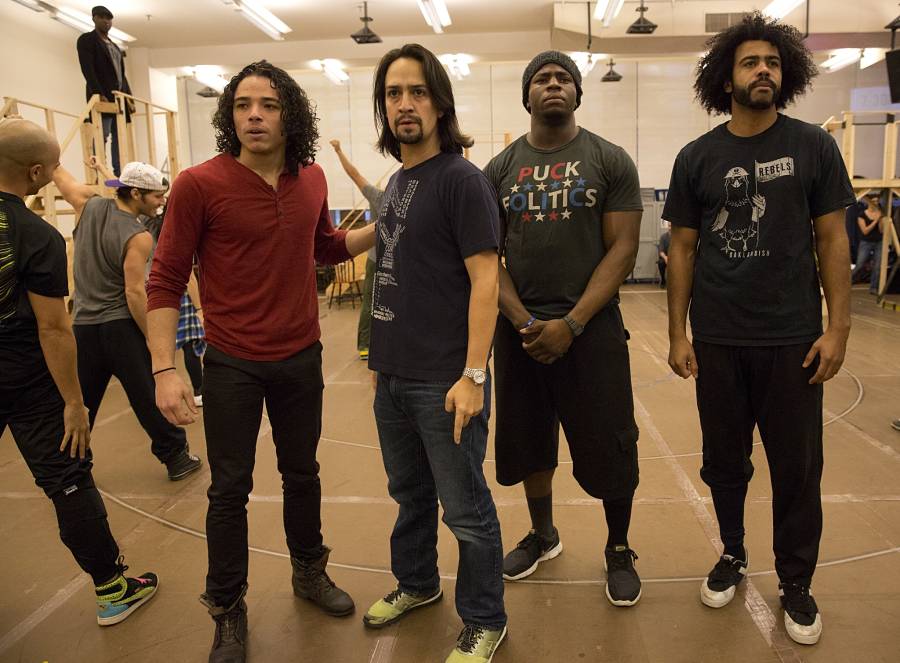The pinned tweet at the top of Lin-Manuel Miranda’s loquacious and ever-popular Twitter timeline reads:
A neighbor shouting from an open window may be part of the lively Washington Heights neighborhood Miranda calls home, and which he memorably theatricalized in his Tony-winning musical In the Heights. But the Shakespeare allusion stands out. While that confused passerby clearly meant to compliment Miranda on his newest mammoth hit, Hamilton—currently selling out on Broadway for the foreseeable future—the association with the author of Hamlet is not a random one.
“I think Lin’s ambitions are Shakespearean, and I think his achievement is Shakespearean,” says Oskar Eustis, artistic director of the Public Theater, where Miranda’s musical about the “10-dollar founding father” played from January to May, encompassing three extensions in an unprecedented sold-out run. “And I run the New York Shakespeare Festival, goddammit!”
Eustis lets out a hearty laugh and goes on to cite several examples, the chief being that both Miranda and Shakespeare elevate the language of the common people to verse. Shakespeare’s meter of choice is iambic pentameter, while Miranda’s is rap and pop. Also as Shakespeare did, Miranda has written a history play, telling the story of America then from the point of view of America now—an aesthetic decision that goes beyond the music and lyrics to encompass the multiethnic casting.
Music is central to the Hamilton coup, though, as the show continues the theatrical revolution that shows like Hair and Rent pioneered, redefining the sound of what a popular theatre score can be. The show’s pop credentials are solid: Questlove and Black Thought of the Roots are executive-producing the original cast recording, out in September on Atlantic Records. But how about the show’s Broadway cred? Hip-hop can get a bad rap on Broadway, as it usually suggests a niche audience that enjoys both showtunes and Jay-Z; shows like last season’s Tupac-scored Holler If You Hear Me can be viewed as cautionary flops. But Miranda, who’s as steeped Broadway musical traditions as in hip-hop freestyle, isn’t using the latter as a gimmick; rather, he’s crafted the form specifically for the stage and for this story.
“A lot of people try to write rap for theatre, and it ends up being really kind of square rhymes and square rhythm,” says Alex Lacamoire, the music director and orchestrator of Hamilton, with whom Miranda worked on In the Heights and Bring It On the Musical. “But here is Lin-Manuel rapping over the bar line, telling stories and doing stuff that is more rhythmically complex than any other writer I have ever heard before. Something about Lin’s music and the way he writes—it percolates. There’s always an undercurrent of rhythm underneath everything that he does.”
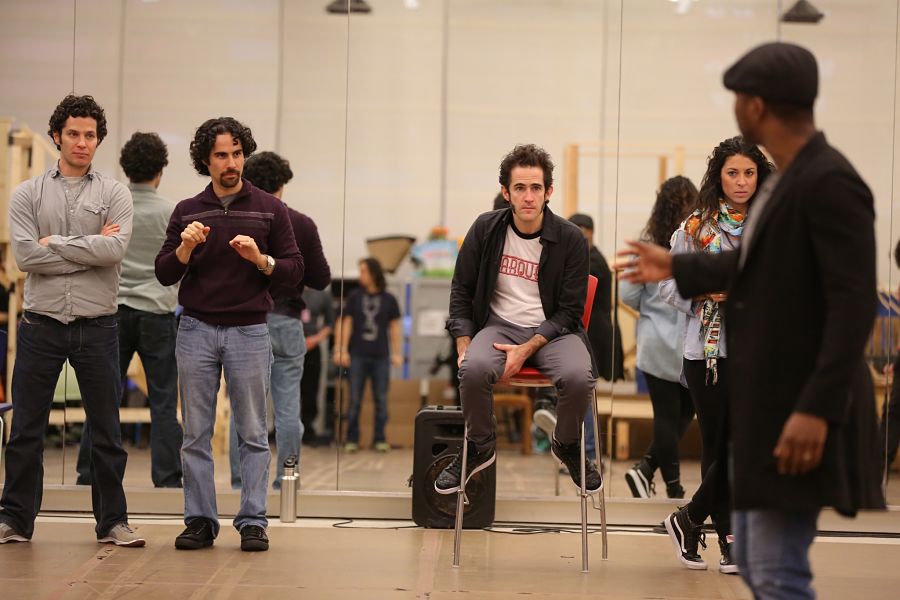
Still, he didn’t always plan Hamilton for the stage—initially, he considered writing the songs as a concept album/mixtape. He first read Ron Chernow’s Alexander Hamilton, on which the show is based (Chernow serves as a historical consultant), while on vacation, and immediately contacted his longtime collaborator Thomas Kail, who also directed In the Heights.
“I have some early G-chats where he’s like, ‘Hey, I got this book. I think it’s really good,’ and I was like, ‘Great, enjoy your vacation. I’ll read the book when you get back. Wear suntan lotion,’” recalls Kail, who met Miranda through mutual friends from Wesleyan University. “Lin is someone who has an incredibly vivid and alive imagination and sense of curiosity, but that doesn’t always spark into him feeling like, ‘I have to write this.’ That happened so instantaneously with Hamilton that it felt like something that was really worth paying attention to.”
On a sunny day in June, after the Public run has closed and Miranda is gearing up for the Broadway run (opening date Aug. 6), I take the subway up to Inwood to meet Miranda at his parent’s modest home across the street from Inwood Hill Park, where Miranda will sometimes walk his dog Tobillo—Tobi for short—and wait for writing inspiration to come. At the second-floor apartment above his mother’s office, Miranda answers the door in casual khakis and a grey T-shirt with “ÑYC” on it, a nod to both his Puerto Rican heritage and his roots in New York, where he grew up. Miranda is a carbon copy of his father Luis, a political consultant, who walks around the house asking Lin if he wants lunch, if he needs anything for the interview, if he has everything set up for the event he has to go to that evening. Miranda responds as you would expect any grown person to respond at their parents’ house, receding gently into the endearing familial roles.
Miranda speaks assuredly in full, thought-through sentences, but his body language almost belies his confidence, as he often shifts and fidgets on the couch, talking with his hands and continually running his fingers through his long hair, which he grew out to play Hamilton. The excitement of a child bubbles just beneath the surface of an eloquent genius.
That energy has proven infectious. Though the show has a massive $27 million ticket sales advance on Broadway, Miranda and his team and cast aren’t acting like the have it made on the Great White Way. Miranda and costar Jonathan Groff constantly tweet with the hashtag #WereInThePlay, comparing their excitement at performing to that of high schoolers. And at a nightly lottery where people can line up outside the theatre two hours before showtime for the chance to win front-row tickets for $10, Miranda and some of his creative team and cast regularly come out to greet the hordes with an impromptu Q&A session here, a mini-performance there—a bit of street theatre affectionately dubbed the #Ham4Ham Show.
On the first night of previews in mid-July, with hundreds of people lined up around the block to put their name in, Miranda delivers this heartfelt message through a megaphone: “Thanks to you, we’re probably going to be here a while, so don’t be disappointed if you don’t win today. I love you very much. Yay Hamlet!”
Following are excerpts from our conversation.
SUZY EVANS: The first time I saw something from Hamilton was when you performed the opening number at the Johnny Mercer Songwriters Project in 2009 at Northwestern University, when I was getting my master’s in journalism. So the journey of Hamilton has almost run parallel to my career as an arts journalist.
LIN-MANUEL MIRANDA: It’s been weirdly public. Going from Heights, where no one knew who the hell we were, and just doing reading after workshop for five years, to really saying, “Hey, I’m writing a musical about this and performing at the White House,” when I’d only written one song. My first real deadline was the American Songbook Series at Lincoln Center; then we had Vassar’s Powerhouse program, where we presented a completed Act One. So we’ve had these weirdly visible benchmarks, which is pretty unprecedented. We jumped out of the plane really early and were like, “All right, I hope there’s a parachute by the time we get to the bottom of this.”
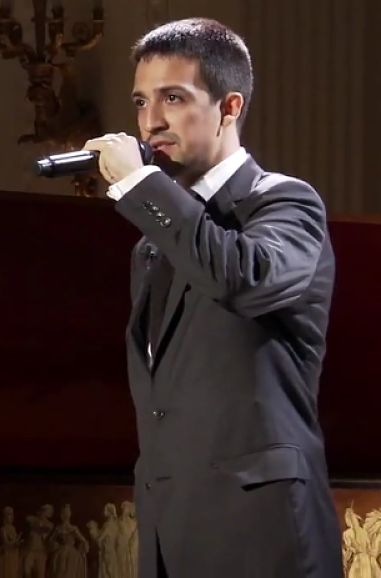
Also, me discovering Twitter as a substitute for caffeine on all my writing jags has been pretty nice. I feel like the people who followed me early on that have been in our process because I’m, within reason, pretty open about what I’m struggling with or what I’m working on. And anyone who wanted to write a thing about the history of the writing of the show could just check my timeline.
When the show was at the Public, the press and marketing people were very discouraging of the term “hip-hop musical.” Would you call it a hip-hop musical, and why or why not?
No, not really. You don’t call Next to Normal a rock musical. You call it a musical. Now, what I love about Next to Normal is that it unapologetically uses rock music and guitar-based music as the idiom and doesn’t apologize for it. Tom Kitt and Brian Yorkey definitively proved this is a valid vocabulary for musical theatre and just kind of did it without apologizing for it and without putting it in quotes. A lot of times in the past when you’ve seen hip-hop used in musical theatre, it has quotes around it. “How crazy! We’re making hip-hop musical theatre!” We don’t comment on it. We just take as a given that it’s the best way to tell Hamilton’s story, but like any other musical score, Hamilton has his own themes that he uses. It’s Peter and the Wolf; it’s what Sondheim does. When you hear this music, you know Burr’s coming onstage; when you hear that music, you know King George is coming onstage. They have their own energy and their own pulse. So in that way, it’s a really traditional musical theatre score. What hip-hop allows me to do is add more lyrics per capita than any other musical going. Its capacity to pack information in a way that is dense but still understandable is incredibly useful.
You initially thought about this show as a mixtape, and then you worked with a playwright on making it a book musical before you finally landed on the sung-through version. Why is this the best way to tell this story?
Yes, that’s all true. There was a version of Act One that had maybe half of the songs that now exist in Act One with scenes in between, and frankly, it didn’t work with the music for this show, because so much of the music is already heightened language. There’s a sort of classic musical theatre axiom: When you can’t speak anymore and emotion heightens, you sing, and if it heightens more than that, you dance. With us, we’re beginning at heightened language, so the inverse became, “All right, now we only go to dialogue if it’s super-important, because there is so little of it.” We learned from doing that exercise with the playwright, who did an amazing job, that the form didn’t serve it—I was already too pregnant with this thing, and I kind of already saw how it was going to work.
The other thing is, thinking of it as a mixtape turned out to be a real blessing in disguise, because I think if I had thought of it as a stage piece from the beginning, I wouldn’t have packed the lyrics as tight as I did. I really approached this with, “I want you to be able to get things on the 10th listening and on the nth listening.” I wanted it to be as dense as my favorite hip-hop albums and my favorite musical albums, where I’m still catching allusions or alliteration or double meanings or triple entendres that I didn’t catch the first time. I wouldn’t have packed it this tight if I were writing for the stage—but by packing it that tight and never letting up on that, I think we’ve ended up with a much richer show.
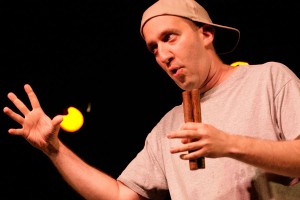
Hamilton owes a debt to hip-hop and pop music from the 1990s and to classic musical theatre. Would you say the show also takes inspiration from hip-hop theatre artists like Will Power and Eisa Davis?
Absolutely. Listen, the same year I started writing In the Heights at Wesleyan, my sophomore year, the fall of that year, Danny Hoch came and performed Jails, Hospitals, & Hip-Hop for us. And that was really seminal to me and really opened my eyes to what hip-hop theatre could be. It wasn’t like he was rapping in the show, but the way he created his characters is the same way we create hip-hop music. He would take an inspiration from here, an inspiration from here, and create these characters you’d never seen before. And in his head, he thinks of it as hip-hop. The fun thing about building a score and employing hip-hop as one of your storytelling tools is that you create a new thing out of old pieces. So there are a lot of musical theatre references; there are a lot of hip-hop references. And then there’s that third Venn diagram of history references. So there are nerds who laugh when King George says, “When you’re gone, I’ll go mad,” because they know King George went fucking mad! And there are the folks who laugh at “And if you don’t know/Now you know,” because that’s a Biggie reference.
Or “Nobody needs to know,” which is a Jason Robert Brown reference.
Exactly. There are Easter eggs for everyone in our Venn diagram, but at the same time, it works on its own terms.
Were there any Easter eggs you had to lose in writing it that you miss?
Yep.
Any you can share?
Not really. [Laughs] There are a couple of things where to pay for the privilege of making that reference would have been too exorbitant. And some of the references I took out because I found them distracting. There was an LL Cool J reference at the top of “Say No to This” that I’ve rewritten because it’s a laugh when I really don’t need a laugh—I need them listening. Some of them are dramaturgical and some of them are legal.
My favorite Easter egg that I’ve ever put in is actually in In the Heights. At the end of Priscilla Lopez’s song in Act 2, “Enough”—it was written between Off Broadway and Broadway, and I knew Priscilla Lopez was going to be singing it, and she’s a powerhouse, and I wanted to honor her—so when she holds that last note, we do a bit of the trumpets from “What I Did For Love.” It’s just a little Chorus Line love note in the orchestration. There’s lots of stuff like that in Hamilton. I don’t want to give them away, because I feel like Rap Genius is going to have a field day finding them.
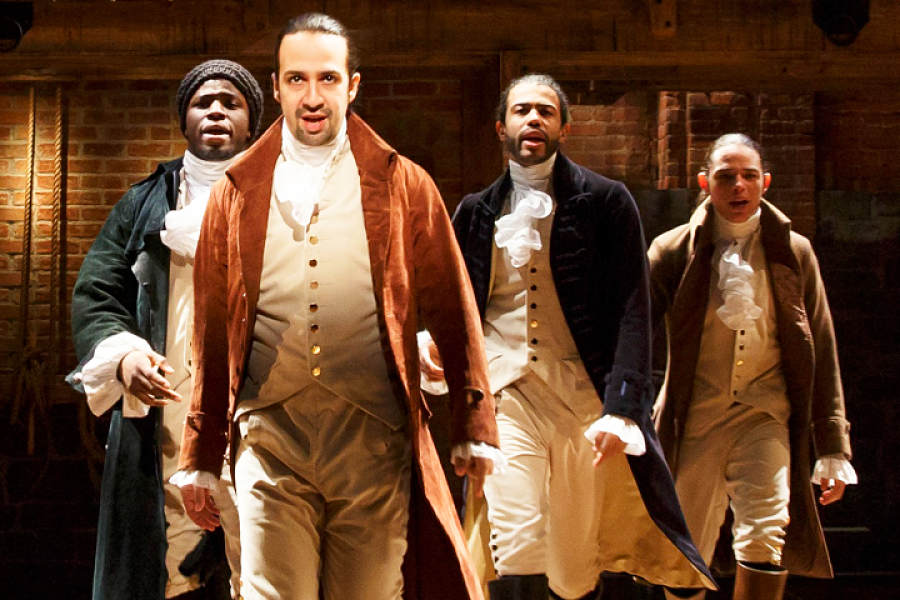
It also seems to be a rarity in musical theatre to have composers who also perform in their shows, and this is your second. Ragni and Rado did it with Hair, and Dave Malloy is in a lot of his work, but you playing Usnavi in Heights was kind of a fluke, right?
It was kind of a fluke. It was Tommy Kail having an instinct about me doing it and following that instinct. My line on that has always been: I fell in the snowball as it rolled down the hill and turned into a bigger snowball. That being said, having done In the Heights and knowing that you can do eight shows a week, you go into the next one with a different set of information. Every time I wrote a song for a character, I was like, “I want to play that character.” And that’s the fun! If you’re doing your job and you’re really inhabiting these characters as you’re writing them, you should want to feel the urge to play all of them. God, if I could play Angelica [Schuyler, Hamilton’s sister-in-law]! Jesus! She has such amazing music in the show. But yeah, it’s really interesting with this one. I just felt I kept going back and forth on Hamilton and Burr, and then when we found Leslie, we found the sound of Burr; no one else was going to play Burr after we heard Leslie in that role. That was really an exciting moment. Then you have the flip side, where you start to actually hear his voice as you’re writing the songs. I love when that happens as a writer—when you’ve got your head around the character and the actor who’s going to be playing them, so you begin to write to their strengths. It happened to me with Chris Jackson [who plays George Washington] very early.
On the other hand, I envy the writers who put their show up and then go have dinner and come back and see their show!
You have Javier Muñoz doing one show a week as Hamilton, so you get to do that once a week.
He’s amazing. I’m really excited about that. For me, the show’s the star; I’m not the star. It really is this ensemble piece. I write high school plays. I fell in love with the theatre in high school by doing theatre in high school, and so I think I write pieces that are great ensemble shows, because that’s what I fell in love with—that spirit of community onstage.
Indeed, this show seems ripe to be done in high schools one day. Do you have notes about casting?
We don’t have anything yet! But yeah, I certainly hope that the casting of this show when it goes to high schools is as diverse as the blueprint we’ve laid out. That’s the importance of precedent. A lot of what’s fun about the rap battles in Hamilton and what our characters do is that they are setting this template for the rest of the country—every time they do something, it sets an American precedent. Washington steps down after two terms, and that becomes the standard max for presidents, because Washington did it. So in that vein, the fact that we have such a diverse cast will hopefully set the precedent for future productions.
That’s one of the best and most notable things about the show, the multiracial casting. Is that something that you consciously decided?
It’s a couple of things. One, it’s a function of the genesis of the show. When I was reading this book, I wasn’t picturing the founding fathers. At the end of the second chapter, I was like, “Oh, this is a hip-hop album.” So I was already dream-casting musicians as the founding fathers in my head when I was reading it for the first time. So it’s been a part of it since before it was a show. And then Tommy’s genius in casting was he said, “This is a story of America then told by America now, and I want to eliminate any distance between a contemporary audience and the story.” The score of 1776, great as it is, does not sound like music from the 1770s; it sounds like musical theatre of its era. So does ours. It’s less drums and fifes, sure, but it’s still contemporary music. Having the cast look like what America looks like just eliminates more distance. It’s like, “Oh, okay, George Washington is not this guy made of stone in South Dakota. He’s Chris Jackson.”
Someone recently asked you on Twitter what current Broadway star you wanted to create a musical for, and you said you want to create new ones. In this show, you have Daveed Diggs, Anthony Ramos, Phillipa Soo, and Jasmine Cephas Jones making their Broadway debuts in big roles, so mission accomplished.
It’s the best! I’ll never forget, by the time Heights got to Broadway, some of us had been involved from the beginning, and it felt like we were bringing our whole family onstage with us. The same is true of Hamilton—even though we have this murderer’s row of people who have both been experienced and in Broadway shows before, like Renee [Elise Goldsberry] and Jonathan Groff, there are also new folks. I saw Pippa Soo in Dave Malloy’s Natasha, Pierre & the Great Comet of 1812, and Tommy and I were both like, “Well, she’s a star.” We were thrilled that we got to work with her on this and for it to be her Broadway debut. I love going to see a show and seeing the stars I love—Sutton Foster and Kelli O’Hara and Chita Rivera—and the history they bring and the relationship we have with them from show to show. But there’s really something exciting about seeing someone new and really not knowing the journey you’re going to go on at the beginning because you don’t have this history. He’s already very well known in the hip-hop world, but introducing the theatre world to Daveed Diggs has been a great joy.
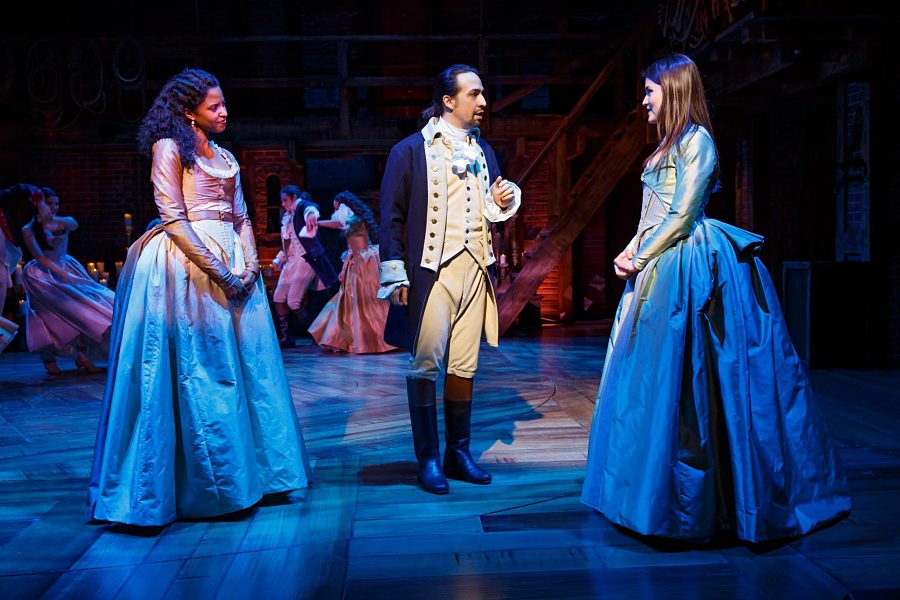
I want to talk about where your love of history comes from. You’re a West Wing nut and your father works in politics. How did you get into history?
I’ve always been a biography buff. I’m not really much of a history buff, that’s the thing. I follow the stories, and I fell in love with Chernow’s version of Hamilton. I recognized the relentlessness. I recognized the self-destructiveness. I recognize the “no one in the room’s realized it yet, but I’m the smartest guy in here” of Hamilton, that energy. I went to a gifted school and I know that kid. And so I fell in love with his version of history, and seeing American history through his eyes made me see it in a totally different way. I think that comes across in the writing of the show—I’m having so much fun telling you because I’m learning it with you as I am writing it. There’s the moment where Aaron Burr says of Hamilton, “Martha Washington named her feral tomcat after him,” and Hamilton goes, “That’s true!” That kind of, “I can’t wait to tell you all the shit I learned in writing this story” really carries across the footlights, because I was learning this stuff in order to write it.
What’s your songwriting process?
They’re all different. Some of them come all at once. “That Would Be Enough,” which is a song Eliza sings to Hamilton in Act One, happened in about 45 minutes. It was the song that needed to happen in that moment, and thank God it all came at once; I worked on the music and lyrics at the same time. You’re very grateful when that happens. More often than not, it’s an idea for a lyric. I think I had the lyrics for “My Shot” way before I ever committed any music under them. And then once I committed music under them, I found that “whoa whoa” that came out of music. I wrote one, which informed the other, which then doubled back and found the lyrical and harmonic underpinnings after the fact.
Some of them, I’ll find a beat I’m just crazy about: I’ll create a beat on my computer and walk around with a loop and walk around with this one [gesturing to his dog on the floor] in the park until I’ve got some words. If I don’t have words after a really long walk, I’ll go, “There’s something inherently in the music I’ve created that’s not doing it. It’s not getting the story.” So it’s about trusting one to carry the other and hopefully having them work together as closely as possible.
You work extremely well with musical themes in both In the Heights and Hamilton, yet every song sounds like Lin-Manuel Miranda. How do you write so specifically for characters while still maintaining your voice as an artist?
I don’t know! It’s so funny. My wife is half-Austrian, and her mom like has a for-real Austrian accent. But my wife is like, “I don’t hear it,” and I’m like, “How do you not?” I look at her like she’s crazy. I think it’s the same thing when it comes to what you’re saying about my songs. I write the songs the best way I know how. I know when I wrote that first closing number for Neil [Patrick Harris] at the Tonys, my phone exploded. He started rapping, and everyone was like, “Are you backstage?” I started getting all these texts from my friends, but I didn’t tell anyone I was writing it!
But you know, I can say the same thing about Kander and Ebb, I can say the same thing about Jason Robert Brown. The guys I like, you can tell what their style is, even though they are incredibly adaptable to the style and genre from show to show. I couldn’t quantify them. I’m sure Forbidden Broadway will at some point totally take the piss out of me and go, “Here are the Lin moves,” and I will laugh and say, “Oh yeah, those are my moves.”
Did you ever consider a pop career apart from the stage?
No, I never had my head around it. I love music, obviously, but I like telling stories more than any of that. It’s all about your way in. I was exposed to musical theatre at a really young age, and I got a chance to do it. If I were in a world where people were writing songs and recording them, maybe that would have been my way in. I fell in love with the theatre. It just used so many parts of my brain. It’s the most fun. It’s the most challenging.
A lot of people from the music industry came to see the show. What was their reaction?
It’s amazing when your heroes—the people you’ve paid money to see in concert—come to see your show. There’s always going to be a kick about that. What’s been sort of wonderful is the generosity we’ve been greeted with from the music world. From Busta Rhymes to fucking Sondheim, it’s been really lovely, because those are our heroes. And you go, “Well did you catch that reference?”
Did they catch them?
Well, I had to tell Andrew Lloyd Webber, “Listen, we’ve got Burr narrating Hamilton’s story—it’s such a nod to the structures of Evita and Jesus Christ Superstar, to have the archnemesis narrating the story.” He was really sweet about that. It’s always fun to be able to tell your heroes the debt you owe them.
I read on Twitter that Sheldon Harnick came to your show and really liked a certain rapper and you made him a mixtape, is that right?
Oh, Sheldon and I have been exchanging hip-hop shit for years! He’s been fascinated with it for a long time, and he and I started talking together in the wake of In the Heights. There’s a reason why Sheldon’s in his 90s and is faster and smarter than you or I. He is the one of the most intellectually curious people I’ve ever met in my life—funny and sharp and with it, and that’s why he’s not aging.
What is it like introducing these greats to the world of hip-hop?
It’s fun for me! I’m just introducing something I love to something else I love—that’s what I feel like my job is. Hamilton is a giant exercise in, here are all these things I fell in love with and this is everything I know about musical theatre right now and here is the show. It is as much as I know. And I think that it’s spoiled me in a sense, because it makes you want to do that every time—really throw everything you got at something.
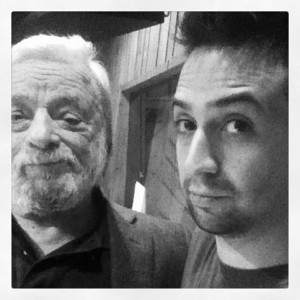
You follow Sondheim’s rules on lyric writing, with the emphasis on perfect rhyme. Does it work the same way when you’re writing something more hip-hop-influenced?
There’s a lot of pure rhyme and there’s a lot of imperfect rhyme, and that’s part of the infusion of hip-hop. In hip-hop you reward the unexpected rhyme. You reward Jay Z rhyming “Sharpton in it” with “dark-skinneded” [in “Diamond is Forever”]—that’s not a pure rhyme, but you laugh because it’s totally unexpected. So I’m constantly threading the needle when writing Hamilton in terms of trying to satisfy a hip-hop ear and a musical theatre ear.
In the Heights is about uptown Manhattan, and with Hamilton, you have a lot of crucial story points happening in New York, many of them uptown. Does your being raised here and having done Heights inform how you approach Hamilton’s story?
It was kind of amazing to write another New York immigrant story, and it’s just a few layers lower—I don’t mean further downtown, I mean under the earth. Knock a few layers of epidermis off this city, and we’d be back in those times. Every corner of New York has something pertaining to the story of Hamilton and the creation of this country. I live near Fort Washington Avenue, which is named after fucking Fort Washington, where Washington is fleeing in “Right Hand Man”! Hamilton’s grange, the house where “It’s Quiet Uptown” takes place, is in the 140s. And it was quiet then—this was sort of uncharted land in terms of the city.
I’ll never forget, I went with the director of the Museum of American Finance, he said, “I want to show you one of my favorite things,” and he went to this very non-descript office building and he showed me this plaque. It was small and brown; blink and you’d miss it. A bunch of people were smoking around it. And it said, “This was the site of Thomas Jefferson’s residence when he lived in New York.” So literally, “The Room Where It Happens” took place on this corner where this non-descript plaque was and you would never have known it! That’s the fun of this story, too, is that it is sort of again a love letter to New York and the things that happened here. It’s always been this hub for creation.
What is it like for you to have Hamilton on Broadway as we’re heading into an election year? Do your own politics affect how you look at it?
I’m a pretty politically moderate guy. I obviously grew up in a Democratic household; my dad is a Democratic political guy. And yes, I would say my politics absolutely affect it, but not politics in the capital P sense of gun control or abortion rights or any of these hot-button social issues. To me, the biggest political takeaway of this is that our founding fathers were not Moses and they did not get tablets from on high. They had fights and they compromised and they did their best to hold this fragile thing together. And they were making it up as they went along and so are we. I promise you this election will not have a worse fight than John Adams and Thomas Jefferson did in the election of 1800, where I think Jefferson called Adams a hermaphrodite and Adams countered, “Jefferson’s dead so you should vote for me.” They were taking advantage of the fact that news got around slowly! Political rancor has existed since about six months after we first had a government, and so I think that reminder is great. I don’t think this is a liberal show or it’s a conservative show. If anything, it’s this reminder that ’twas ever thus.
The word-of-mouth explosion while the show was at the Public was insane. Does that create a certain amount of expectation for you moving to Broadway?
What’s been amazing is that Tommy has stuck to his guns in terms of the production he wanted. We were lucky to be with producers and in a space at the Public Theater that gave him exactly what he asked for—no more, no less. If anything, it didn’t create expectations that scared us; it emboldened us. We said, “Okay, we’ve worked at the right pace and we’ve made the thing we want to make, let’s continue to do that. Let’s not let the outside world affect the decisions we make.” That’s not to say we don’t let the audience affect us, because the audience is our last collaborator. But in terms of the outside world—”you should move now” or “you should move later” or “you should cut 15 minutes”—that’s not interesting to us. What got us here was the conversations we all had. The outside world input is great and fine, and if it sticks in your stomach and you can’t stop thinking about it, maybe there’s something to it. For the most part, we’re just continuing to have the conversations that we’ve been having for the past six years.
Didn’t you tell a group of critics that you weren’t going to cut 15 minutes of your show at the New York Drama Critics Circle awards?
Yeah, I said that in an acceptance speech. I feel no pressure to cut for time, because I know that the audience we had Off Broadway had a good time at our show and had a satisfying experience. I want the time you spend at our show to feel like you want to be there another two hours; I don’t ever want to exhaust you. I want to tell the story as completely as possible, and so our goal is to just make the thing sharper and to make the thing better. If that results in us cutting time, great. If that results in us adding time, great. I don’t care about the final running time, because we’re not in any danger of going into crazy overtime. It’s about making the best show possible. It’s very easy to say, “Cut 15 minutes,” from the cheap seats. For us, it’s just about telling the best story. The running time will be what the running time will be.
With Hamilton such a massive success, are you nervous about your next project?
No. What was fun after In the Heights is I just went and did a bunch of jobs that I knew I was going to learn from—West Side Story, working with Stephen Schwartz on Working, Bring It On with Tom [Kitt] and Amanda [Green]. I got like five new moves out of that. Tom and I have been friends for a long time, but it’s different when you’re in the room and you’re making the thing together. And watching Amanda and the way she approached lyric writing, I learned moves from her. So I will just keep doing that. LeBron James goes and works on whatever he’s weakest at in the off season, and that’s what I’m going to go do. Hamilton will be up, and I’ll go work with songwriters I really love. One of the benefits of these hip-hop artists who come to the show who I really revere—like, I’ll go sit in a studio and see how they write. Or I’ll go maybe work on a screenplay or something. I just want to get better at the things I don’t know. That’s the goal. Because that’s the fun of it. If I want to be Sheldon Harnick, I have to keep learning the shit I don’t know. He is still learning, and I want to be in the same boat as him!

